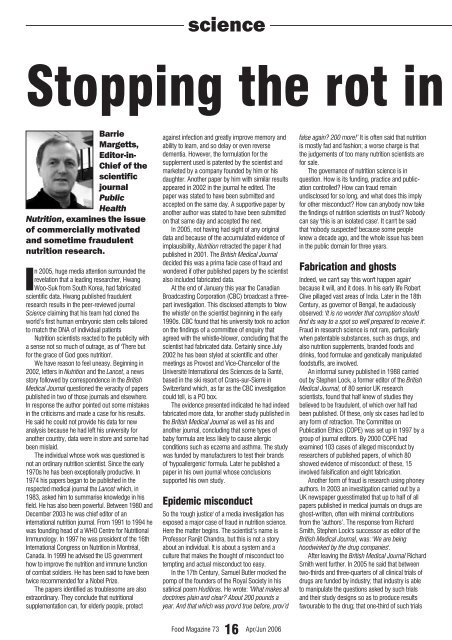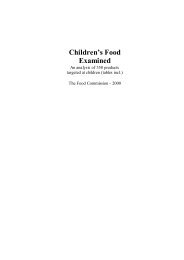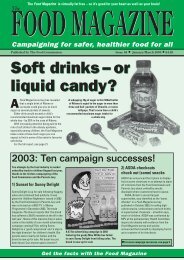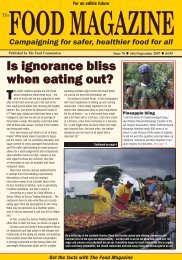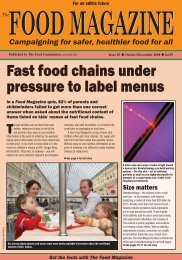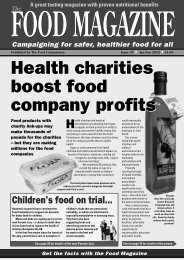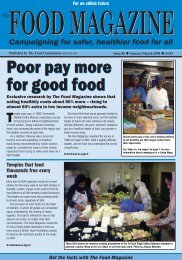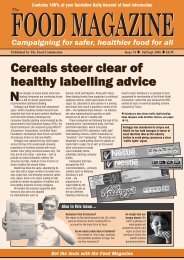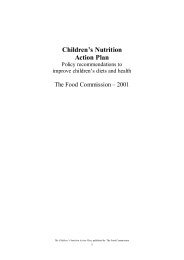Campaigning for safer, healthier food for all - The Food Commission
Campaigning for safer, healthier food for all - The Food Commission
Campaigning for safer, healthier food for all - The Food Commission
Create successful ePaper yourself
Turn your PDF publications into a flip-book with our unique Google optimized e-Paper software.
science<br />
Stopping the rot in<br />
Barrie<br />
Margetts,<br />
Editor-in-<br />
Chief of the<br />
scientific<br />
journal<br />
Public<br />
Health<br />
Nutrition, examines the issue<br />
of commerci<strong>all</strong>y motivated<br />
and sometime fraudulent<br />
nutrition research.<br />
In 2005, huge media attention surrounded the<br />
revelation that a leading researcher, Hwang<br />
Woo-Suk from South Korea, had fabricated<br />
scientific data. Hwang published fraudulent<br />
research results in the peer-reviewed journal<br />
Science claiming that his team had cloned the<br />
world’s first human embryonic stem cells tailored<br />
to match the DNA of individual patients<br />
Nutrition scientists reacted to the publicity with<br />
a sense not so much of outrage, as of '<strong>The</strong>re but<br />
<strong>for</strong> the grace of God goes nutrition'.<br />
We have reason to feel uneasy. Beginning in<br />
2002, letters in Nutrition and the Lancet, a news<br />
story followed by correspondence in the British<br />
Medical Journal questioned the veracity of papers<br />
published in two of those journals and elsewhere.<br />
In response the author pointed out some mistakes<br />
in the criticisms and made a case <strong>for</strong> his results.<br />
He said he could not provide his data <strong>for</strong> new<br />
analysis because he had left his university <strong>for</strong><br />
another country, data were in store and some had<br />
been mislaid.<br />
<strong>The</strong> individual whose work was questioned is<br />
not an ordinary nutrition scientist. Since the early<br />
1970s he has been exception<strong>all</strong>y productive. In<br />
1974 his papers began to be published in the<br />
respected medical journal the Lancet which, in<br />
1983, asked him to summarise knowledge in his<br />
field. He has also been powerful. Between 1980 and<br />
December 2003 he was chief editor of an<br />
international nutrition journal. From 1991 to 1994 he<br />
was founding head of a WHO Centre <strong>for</strong> Nutritional<br />
Immunology. In 1997 he was president of the 16th<br />
International Congress on Nutrition in Montréal,<br />
Canada. In 1999 he advised the US government<br />
how to improve the nutrition and immune function<br />
of combat soldiers. He has been said to have been<br />
twice recommended <strong>for</strong> a Nobel Prize.<br />
<strong>The</strong> papers identified as troublesome are also<br />
extraordinary. <strong>The</strong>y conclude that nutritional<br />
supplementation can, <strong>for</strong> elderly people, protect<br />
against infection and greatly improve memory and<br />
ability to learn, and so delay or even reverse<br />
dementia. However, the <strong>for</strong>mulation <strong>for</strong> the<br />
supplement used is patented by the scientist and<br />
marketed by a company founded by him or his<br />
daughter. Another paper by him with similar results<br />
appeared in 2002 in the journal he edited. <strong>The</strong><br />
paper was stated to have been submitted and<br />
accepted on the same day. A supportive paper by<br />
another author was stated to have been submitted<br />
on that same day and accepted the next.<br />
In 2005, not having had sight of any original<br />
data and because of the accumulated evidence of<br />
implausibility, Nutrition retracted the paper it had<br />
published in 2001. <strong>The</strong> British Medical Journal<br />
decided this was a prima facie case of fraud and<br />
wondered if other published papers by the scientist<br />
also included fabricated data.<br />
At the end of January this year the Canadian<br />
Broadcasting Corporation (CBC) broadcast a threepart<br />
investigation. This disclosed attempts to 'blow<br />
the whistle' on the scientist beginning in the early<br />
1990s. CBC found that his university took no action<br />
on the findings of a committee of enquiry that<br />
agreed with the whistle-blower, concluding that the<br />
scientist had fabricated data. Certainly since July<br />
2002 he has been styled at scientific and other<br />
meetings as Provost and Vice-Chancellor of the<br />
Université International des Sciences de la Santé,<br />
based in the ski resort of Crans-sur-Sierre in<br />
Switzerland which, as far as the CBC investigation<br />
could tell, is a PO box.<br />
<strong>The</strong> evidence presented indicated he had indeed<br />
fabricated more data, <strong>for</strong> another study published in<br />
the British Medical Journal as well as his and<br />
another journal, concluding that some types of<br />
baby <strong>for</strong>mula are less likely to cause <strong>all</strong>ergic<br />
conditions such as eczema and asthma. <strong>The</strong> study<br />
was funded by manufacturers to test their brands<br />
of 'hypo<strong>all</strong>ergenic' <strong>for</strong>mula. Later he published a<br />
paper in his own journal whose conclusions<br />
supported his own study.<br />
Epidemic misconduct<br />
So the 'rough justice' of a media investigation has<br />
exposed a major case of fraud in nutrition science.<br />
Here the matter begins. <strong>The</strong> scientist’s name is<br />
Professor Ranjit Chandra, but this is not a story<br />
about an individual. It is about a system and a<br />
culture that makes the thought of misconduct too<br />
tempting and actual misconduct too easy.<br />
In the 17th Century, Samuel Butler mocked the<br />
pomp of the founders of the Royal Society in his<br />
satirical poem Hudibras. He wrote: ‘What makes <strong>all</strong><br />
doctrines plain and clear? About 200 pounds a<br />
year. And that which was prov'd true be<strong>for</strong>e, prov’d<br />
false again? 200 more!’ It is often said that nutrition<br />
is mostly fad and fashion; a worse charge is that<br />
the judgements of too many nutrition scientists are<br />
<strong>for</strong> sale.<br />
<strong>The</strong> governance of nutrition science is in<br />
question. How is its funding, practice and publication<br />
controlled? How can fraud remain<br />
undisclosed <strong>for</strong> so long, and what does this imply<br />
<strong>for</strong> other misconduct? How can anybody now take<br />
the findings of nutrition scientists on trust? Nobody<br />
can say 'this is an isolated case'. It can't be said<br />
that 'nobody suspected' because some people<br />
knew a decade ago, and the whole issue has been<br />
in the public domain <strong>for</strong> three years.<br />
Fabrication and ghosts<br />
Indeed, we can't say 'this won't happen again'<br />
because it will, and it does. In his early life Robert<br />
Clive pillaged vast areas of India. Later in the 18th<br />
Century, as governor of Bengal, he audaciously<br />
observed: 'It is no wonder that corruption should<br />
find its way to a spot so well prepared to receive it'.<br />
Fraud in research science is not rare, particularly<br />
when patentable substances, such as drugs, and<br />
also nutrition supplements, branded <strong>food</strong>s and<br />
drinks, <strong>food</strong> <strong>for</strong>mulae and genetic<strong>all</strong>y manipulated<br />
<strong>food</strong>stuffs, are involved.<br />
An in<strong>for</strong>mal survey published in 1988 carried<br />
out by Stephen Lock, a <strong>for</strong>mer editor of the British<br />
Medical Journal, of 80 senior UK research<br />
scientists, found that half knew of studies they<br />
believed to be fraudulent, of which over half had<br />
been published. Of these, only six cases had led to<br />
any <strong>for</strong>m of retraction. <strong>The</strong> Committee on<br />
Publication Ethics (COPE) was set up in 1997 by a<br />
group of journal editors. By 2000 COPE had<br />
examined 103 cases of <strong>all</strong>eged misconduct by<br />
researchers of published papers, of which 80<br />
showed evidence of misconduct: of these, 15<br />
involved falsification and eight fabrication.<br />
Another <strong>for</strong>m of fraud is research using phoney<br />
authors. In 2003 an investigation carried out by a<br />
UK newspaper guesstimated that up to half of <strong>all</strong><br />
papers published in medical journals on drugs are<br />
ghost-written, often with minimal contributions<br />
from the ‘authors’. <strong>The</strong> response from Richard<br />
Smith, Stephen Lock's successor as editor of the<br />
British Medical Journal, was: 'We are being<br />
hoodwinked by the drug companies'.<br />
After leaving the British Medical Journal Richard<br />
Smith went further. In 2005 he said that between<br />
two-thirds and three-quarters of <strong>all</strong> clinical trials of<br />
drugs are funded by industry; that industry is able<br />
to manipulate the questions asked by such trials<br />
and their study designs so as to produce results<br />
favourable to the drug; that one-third of such trials<br />
<strong>Food</strong> Magazine 73 16<br />
Apr/Jun 2006


